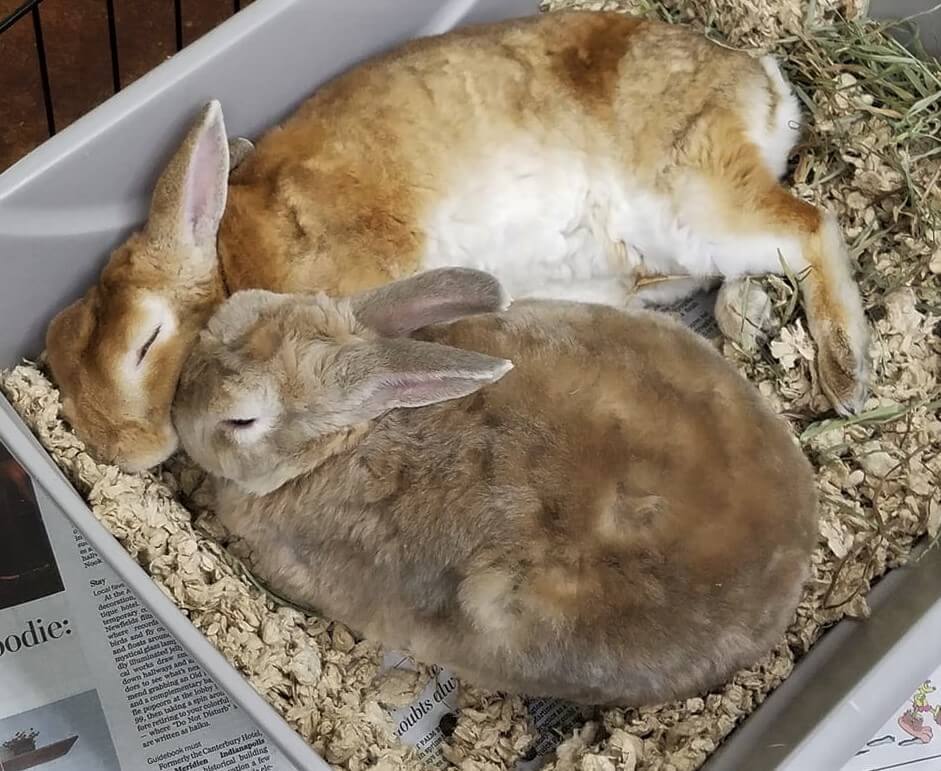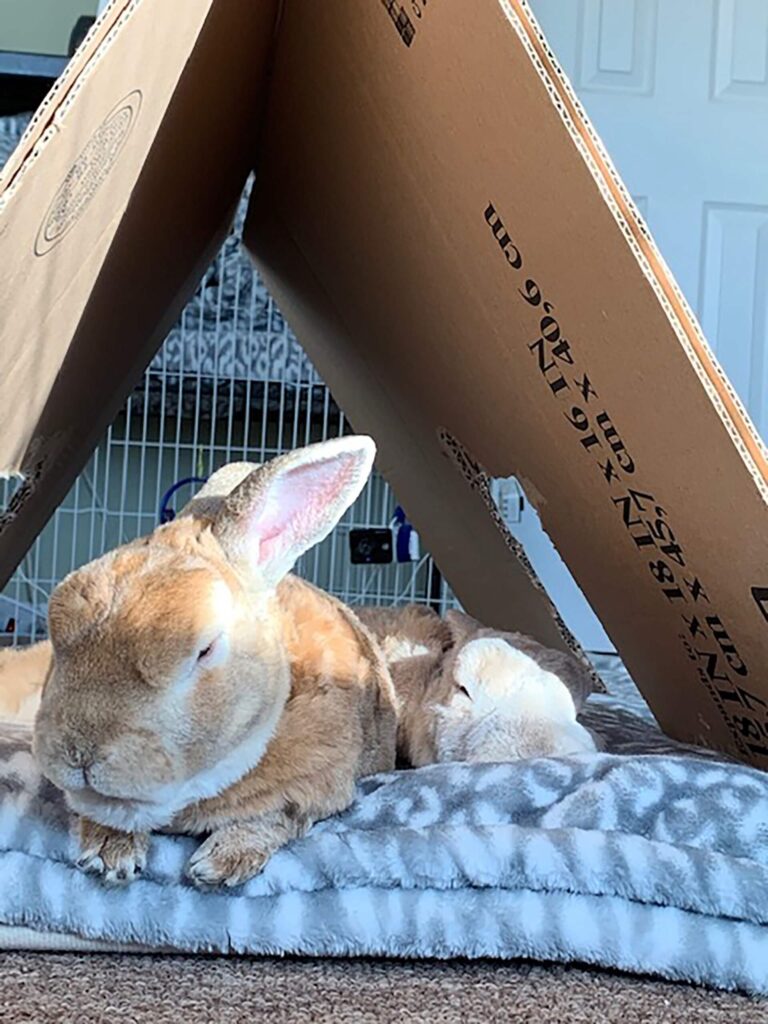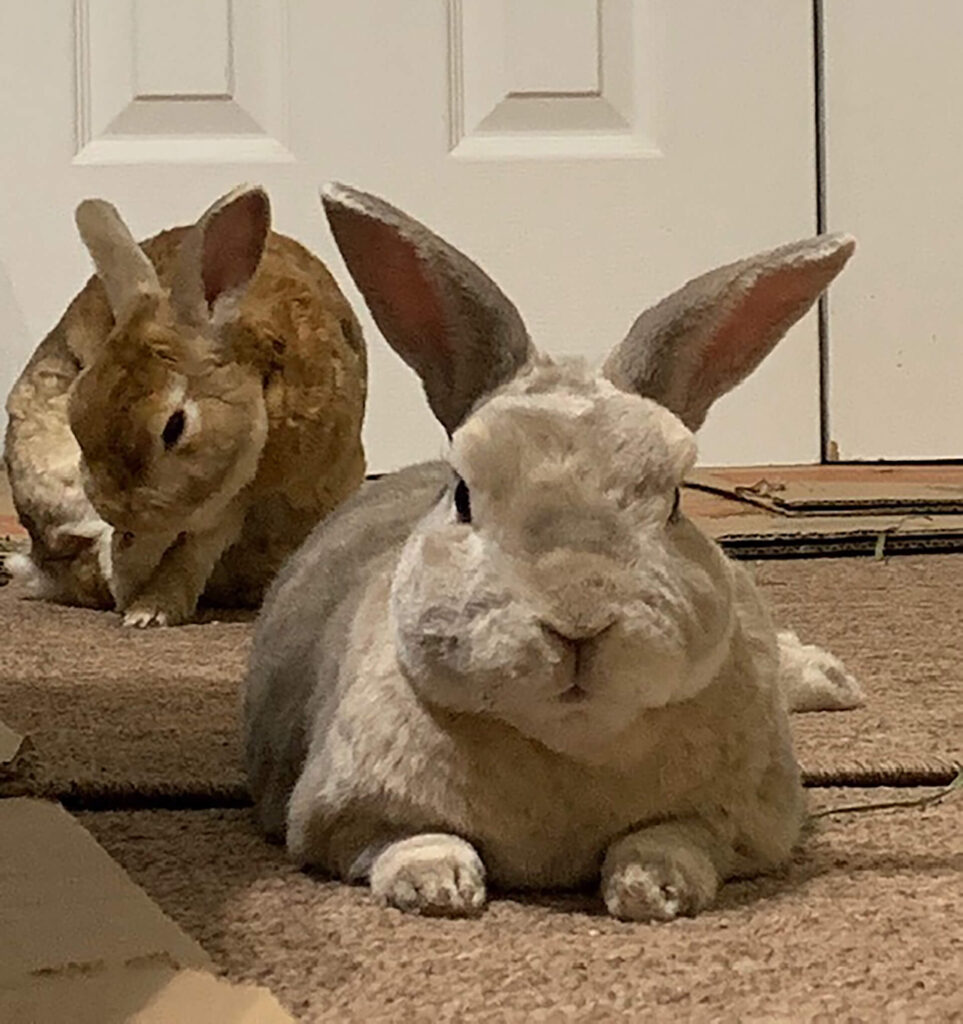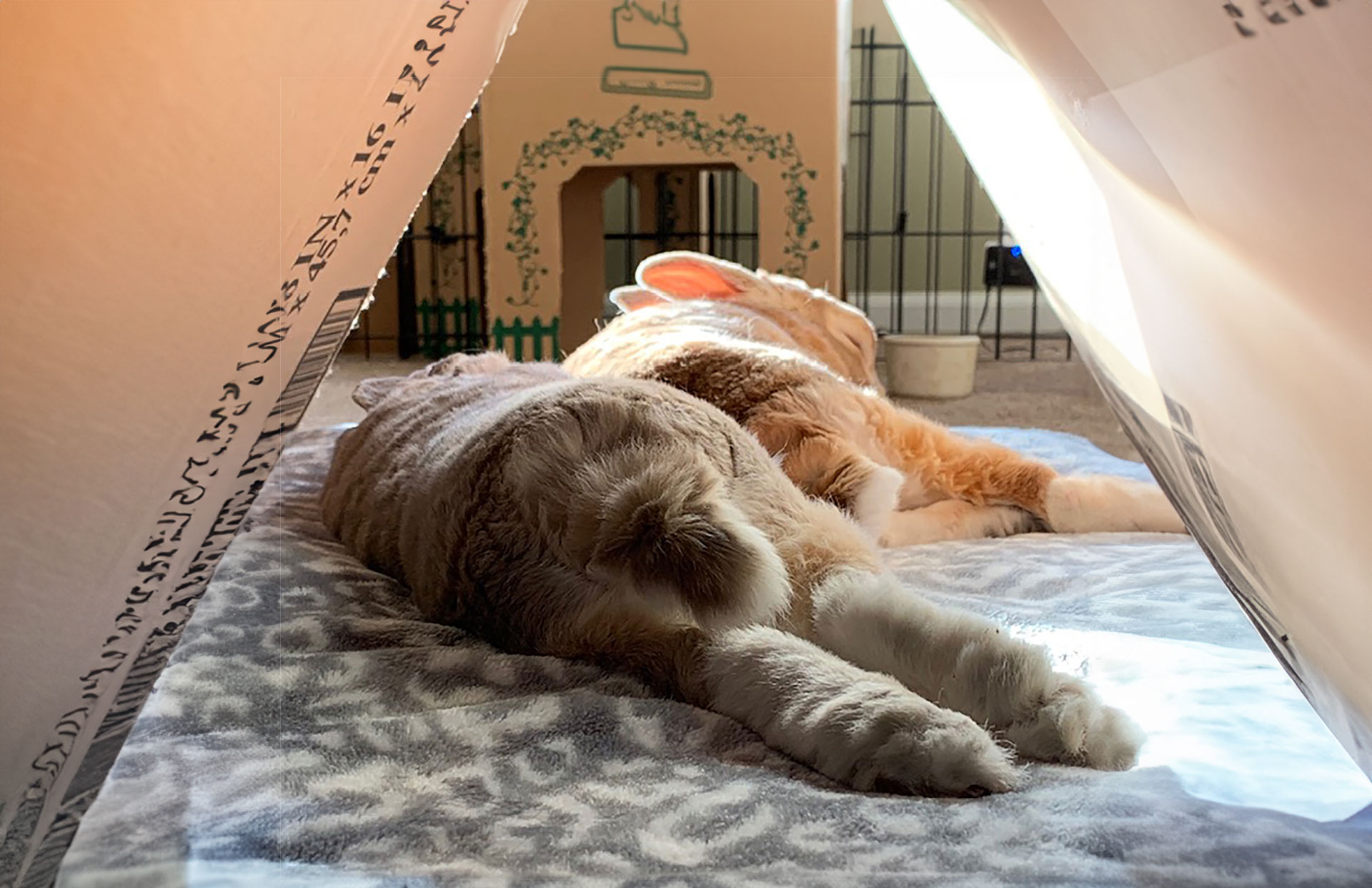Edgar and Fergus came into our lives on a dreary February day in 2018. While scrolling through Facebook one morning, I saw a post from a local rescue asking for help in transporting two rabbits from Delaware to Maryland. By chance, my husband and I were in Delaware that weekend and were available to help with their relocation. Little did I know such a simple task would turn into a complicated and beautiful journey.
When we arrived at the home of the woman who rescued the two small rabbits, we were horrified to learn their story. They had been locked together in a tiny cage and dumped in a cornfield, left to die from exposure or starvation. When finally found, they were barely alive. Their rescuer wasn’t familiar with rabbit care but had managed against all odds to keep them alive. It was a tremendous feat. They were still emaciated and had no muscle, each weighing barely three pounds. As I examined them, I noticed their skin was abnormally thickened and full of hard nodules and scars. It was like armor, in many places a quarter to a half-inch thick. They were also unneutered, in need of flea treatment, and very fearful. Their coats were dull and sparse, and their nails badly overgrown.
After the loss of our previous rabbits, Snicket and Boo, we weren’t sure our hearts were ready for new rabbits. But somewhere amidst the winter cornfields of Delaware Rt. 13, I realized the universe had brought us together. We coordinated with the rescue and the rabbits were examined by a veterinarian, neutered, and treated for parasites. Their skin nodules were examined, but the results were inconclusive. We brought them home and named them Edgar and Fergus. Edgar’s face and was broad and square, and his fur rust-colored with white-tipped ears and underbelly. Fergus’ face was narrower and triangular, and his fur a dusty lilac grey except for a similar white belly and ears.
The boys were estimated to be about two years old and terrified of everything. They had never seen a litter box and had no idea how to use one. They didn’t know how to play, binky, or flop. The abuse they suffered caused significant physical, emotional, and behavioral repercussions. They had also been kept in such a small cage while unneutered that they were prone to fighting. We had a huge undertaking ahead of us. We needed to repair their bond, decrease their fear, and help them learn how to be rabbits.

Very quickly we realized we needed to start them in a smaller space to help decrease their territorial behavior. They were still hormonal and were spraying urine everywhere in a Jackson Polluck-esque fashion. The carpet was a minefield of bunny poop, precisely dropped (it seemed) at one-inch intervals, with astounding mathematical prowess. It took many months to improve their litter box habits. Gradually we worked on expanding their space and introducing new things. Many donation trips were made to the local shelters after Edgar and Fergus refused a new toy because it seemed scary or they disliked one particular food item. It was a continual trial and error. They looked at us with fierce disapproval when they were presented with hay, greens, a healthy new pelleted diet, and water bowls. They also refused to drink tap or filtered water, so we had to buy them bottled water.
Further complicating their transition into our home was that they were (rightfully) entirely distrustful and scared of people. We began a long process of interacting with them in non-threatening encounters, letting them come to us and refraining from petting them or attempting to pick them up. Gradually, they would approach us for a bite of dried cranberry or apple. We learned that bananas, grapes, pineapple, and herbs or anything too round would be met with blatant disapproval, but an occasional one-finger, three-stroke head rub was OK. The sound of toenail clippers clicking caused panic but running a dust buster was OK.
It seemed like we were finally getting a handle on their behavior issues when the extent of their medical needs became clearer. Fergus spent a week in the hospital after I found him limp and cold one morning, with a temperature of 96 degrees. We trimmed his tiny molar points in case that contributed to his stasis and did a biopsy of one of the skin nodules. He was diagnosed (and Edgar by default) with cutaneous fibroma, a condition that could later develop into cancer.

At first, we thought Fergus’ stasis might be stress-induced. A lot had changed. But then I noticed both rabbits seemed to be in a general state of discomfort and were a bit sluggish in their litter box. Fergus had two more episodes of stasis. His bloodwork and radiographs were normal. After yet another incidence of severe stasis, we did a CT scan to make sure there wasn’t something serious we were missing. There were no significant findings. In close consultation with our vet, both rabbits were put on cisapride and gabapentin indefinitely, which helped, but still wasn’t enough. We also added simethicone and Metacam on occasion and altered their diet. It was an exhausting and discouragingly expensive start with our new rabbits.
To their credit, both Edgar and Fergus took to syringe training quickly, so we were able to avoid stressing them when administering their medications. We tried numerous flavor formulations from a number of pharmacies to find an acceptable balance so they would take their medications happily and voluntarily.
Despite our best efforts, Fergus still continued to suffer frequent episodes of stasis. Edgar, luckily, was better able to withstand his GI issues, and normally responded to pain medication, heat, and massage. I kept our bunny emergency kit (assembled in a fishing tackle box) stocked with heating pads, lactated ringers, syringes, thermometers, needles, meloxicam, Critical Care, and buprenorphine for injection (prescribed by our vet for emergencies). I lost count of the number of nights spent trying to nurse them through stasis or trips to the vet for hospitalization. We monitored them with cameras in their enclosure and tried to keep their day-to-day lives peaceful, even though my husband and I lived in a constant state of worry about their health and what seemed like impending financial ruin from relentless vet bills.
Somewhere along the way, and despite the frequent trips to the vets, needle pokes, and assisted feedings, Edgar and Fergus started to trust us and feel safe in their new home. It began with an occasional nose bump and then marking and chinning. They allowed us some brief head rubs. We gradually added space to their enclosure and introduced them to mazes and tunnels. They began to sunbathe and sleep in the open. Then one day we heard a long-absent noise—the sound of chewing on cardboard! They had begun to chew for fun, which they had never done because the concept of play was entirely foreign to them. They had never had toys or space to play. We were utterly delighted. We cycled through various toy trials before we discovered they preferred one specific willow toy (square, not circular), and berry-flavored balsa block chews.
Watching Edgar and Fergus play and engage in bunstruction was immensely gratifying, but nothing compared to seeing them learn to flop and binky. The first binky was a little head shake and chest lift, but before long they were big jumps. My heart sang with joy. Edgar and Fergus were happy with us!

It was wonderful to see their personalities emerge. Fergus was bossy, fastidious, and very particular. Edgar was laid-back, goofy, and messy. He only slept in his bed if the blanket was wrinkled, while Fergus preferred his blanket to be folded in a perfect rectangle.
Slowly we settled into a daily rhythm. Morning meds and pellets, bunny room clean up, sunbathing, naptime, litter box destruction, evening meds and pellets, and playtime. We trimmed their molars every two months and continued to make trips to the vet on occasion for severe stasis. Their coats improved, they gained weight, and got stronger. I thought we had finally reached a fragile homeostasis. But in January of this year at the beginning of the COVID-19 pandemic, Edgar had a sudden episode of pain so extreme I thought he might die. His respiration and heart rate were too fast to count, and his body shook. We rushed to the vet. His test results were perfectly normal. We performed a CT scan of his skull. What we found was shockingly unexpected; a cerebral aneurysm. We were unsure if he had suffered a bleed or what had happened. We were devastated.
There were no case studies or literature to fall back on; none of the specialists had seen this before. Edgar spent a week in the hospital with Fergus by his side. We knew if it were possible for him to come home, Edgar needed to be able to be a comfortable, happy rabbit who would eat on his own and enjoy life. Slowly, he began to show positive signs. We stopped the assisted feedings once he ate voluntarily. We discontinued his opioid pain medication, as he seemed comfortable on gabapentin and meloxicam. He didn’t exhibit neurological symptoms, but did seem to have periodic “headaches,” or moments of some sort of head pain. During these episodes he seemed uncomfortable, sensitive to light, head shy, and more likely to sleep in dark, secluded places. We noted some teeth grinding and squinting. There was no indication of pain anywhere else. His symptoms resolved with additional pain medication, and then Edgar seemed happy and continued to eat well. He played and groomed, and spent time with Fergus. He enjoyed his treats. We changed the lightbulbs in the rabbit room to a softer variety and tried to shield him from loud noises. He clearly hadn’t given up, so neither did we. We felt we were making progress. Edgar binkyed when he came home from the hospital and I burst into tears. These two rabbits exuded such sweetness, kindness, and determination despite everything they had endured.
We settled into a careful routine of treating Fergus’ stasis and Edgar’s headaches. They were still happy, playful, and adventurous. Then in April, I began to notice Fergus seemed to be in pain when swallowing. His teeth were checked repeatedly and there was nothing wrong with his mouth or throat. Radiographs and ultrasound of his chest revealed a thymoma (suspected lymphoma). We started him on prednisolone to try and reduce the inflammation and stall the growth of the tumor. Radiation was not a viable option due to the stress of frequent car trips and anesthesia. We brought Fergus home. Then Edgar’s stools began just slightly decreasing in size. Everything else was entirely normal. We found nothing on exam. In mid-May, he developed terrible abdominal pain late one Saturday night. I spent the weekend nursing him at home until our vet opened on Monday morning. After a few days in the hospital, he was still declining despite intensive care. We did a CT scan and found he had cancer. His cecum and intestines were being ravaged by lymphoma. He was unable to make stool, stopped eating, became more painful, and diarrhea continually leaked out of him. We euthanized Edgar the same day we got his CT results. My heart shattered. Edgar had suffered and survived so much already and had only just begun to know peace, safety, and love. It was another crushing blow in an already terrible battle.
Fergus has shown resilience yet again in surmounting the loss of his partner. He mourned for Edgar but has settled into his life as a solitary rabbit. He seems to enjoy being the undisputed king of his domain. He binkies and plays, and has begun, for the first time in two years, to give me kisses. He lets me pet him a lot more and is living his best life nibbling my husband’s socks, digging in our bedroom curtains, and herding us around the second floor into appropriate “human zones” where he allows us to stand or walk. He enjoys his treats and toys, begs for extra pellets, and still visits Edgar’s bed now and again.
The last two years with Edgar and Fergus have been a humbling, frustrating, scary, financially straining, and uniquely beautiful experience. I’ve often felt overwhelmed and out of my depth, even as a Licensed Veterinary Technician. I never expected two young rabbits to be diagnosed with cancer and a cerebral aneurysm. I miss Edgar deeply and worry about when Fergus’s thymoma will progress; the best hope is he survives for a few more months. But surprisingly enough, we have somehow—albeit haltingly and as a result of many failures—(sort of) figured things out. We are trying to accept life as it comes, with all of its challenges and graces, and to cherish every binky, flop, and sunspot along the way. I’m only glad we were able to provide Edgar with some measure of love and happiness in his short life. I will always remember with deep joy the sight of him snuggled in a nest of fuzzy blankets for an afternoon nap or flopping down inside a fresh litter box to bask in the morning sun. Similarly, seeing Fergus pancaked on the carpet, fully stretched out and sleeping in the open, or binkying after a successful day of curtain arranging never fails to lift my spirits.
And so I must strive to meet their example; to live in the present and try not to obsess about things I cannot control. To stop worrying about what may happen tomorrow so I don’t miss the binky-worthy things today. To treat others with kindness and gratitude. To love freely. To celebrate the small victories every day. To try my best to meet my own challenges and adapt to unexpected realities. To remember to take naps in the sunshine and do things that bring me joy. And to sometimes forget the calories and enjoy the treats. Today, more than ever before, I must remind myself to keep moving forward with love, grit, and determined optimism, and to remember there is always hope to be found, even in the most unlikely circumstances. I am forever grateful for the strength, fortitude, and gentle spirits of my two tiny rabbits, and I am undoubtedly a better person for having shared my life, and heart, with Edgar and Fergus.
With many thanks to Drs. S.S., G.C., O.R., E.N., and all of the outstanding staff at Stahl Exotic Animal Veterinary Services, for their professional excellence, generosity, kind hearts, and patience. We’d be lost without you.
Reviewed by HRS staff
Author: Erica LaFramboise, L.V.T, B.A.Photo Credit: Erica LaFramboise
Journal Issue: House Rabbit Journal, Winter 2020




